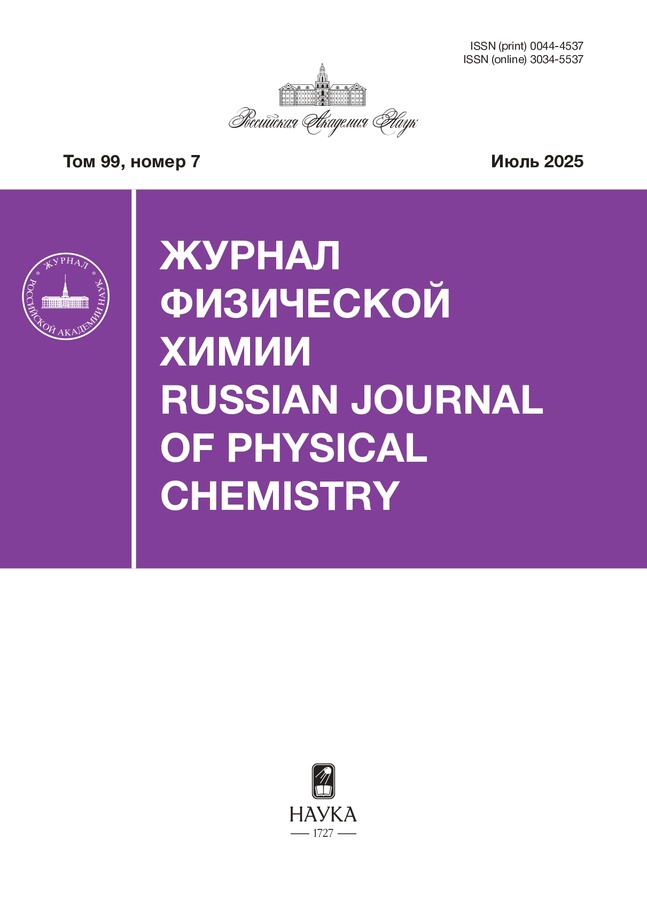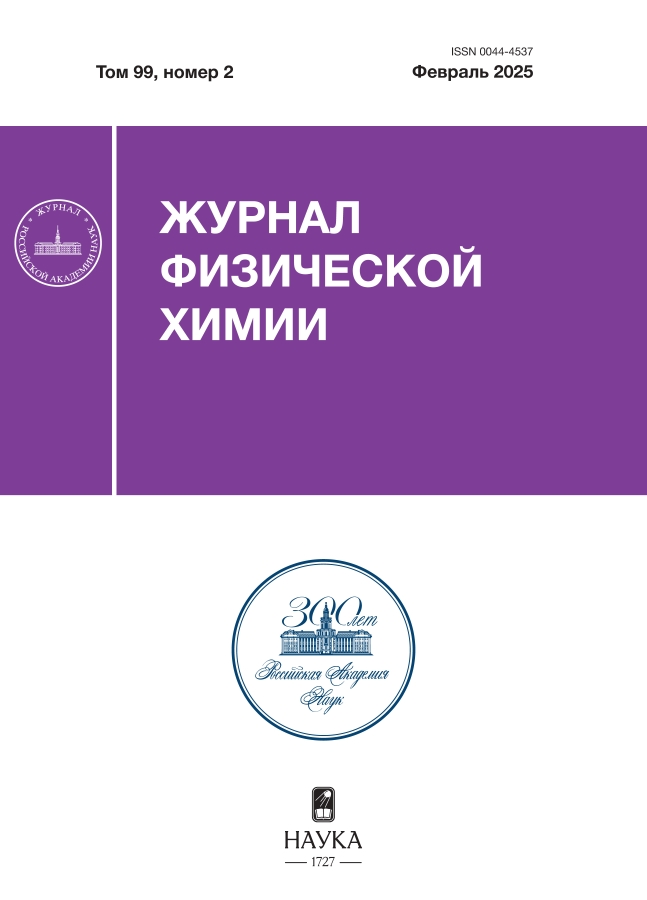Электронное состояние родия в катализаторах окислительного карбонилирования метана в уксусную кислоту на основе Rh/НZSM-5: влияние добавок меди и цинка
- Авторы: Шилина М.И.1, Храмов Е.В.2, Батова Т.И.3, Колесниченко Н.В.3
-
Учреждения:
- Московский государственный университет им. М. В. Ломоносова
- Национальный исследовательский центр “Курчатовский институт”
- Институт нефтехимического синтеза им. А. В. Топчиева РАН
- Выпуск: Том 99, № 2 (2025)
- Страницы: 309-318
- Раздел: ФИЗИЧЕСКАЯ ХИМИЯ ДИСПЕРСНЫХ СИСТЕМ И ПОВЕРХНОСТНЫХ ЯВЛЕНИЙ
- Статья получена: 19.06.2025
- Статья опубликована: 20.05.2025
- URL: https://hum-ecol.ru/0044-4537/article/view/685281
- DOI: https://doi.org/10.31857/S0044453725020172
- EDN: https://elibrary.ru/DDBUGV
- ID: 685281
Цитировать
Полный текст
Аннотация
Методами инфракрасной спектроскопия диффузного отражения адсорбированного монооксида углерода и рентгеновской абсорбционной спектроскопии исследовано влияние второго легирующего металла (Zn, Cu) на электронное состояние и локальную структуру родия на поверхности цеолитного катализатора Rh/НZSM-5. Установлено, что введение меди и цинка способствует повышению устойчивости родия к агрегации (образованию кластеров) в условиях реакции окислительного карбонилирования метана в уксусную кислоту. По сравнению с монометаллическим катализатором Rh/НZSM-5, где одноатомные родиевые центры частично агрегируются в кластеры, в случае Rh-Zn/НZSM-5 доля Rh0 уменьшается в два раза, а в случае Rh-Cu/НZSM-5 кластеризация Rh не происходит. Стабилизирующее действие Cu обусловлено взаимодействием катионов меди и родия на поверхности цеолита.
Полный текст
Об авторах
М. И. Шилина
Московский государственный университет им. М. В. Ломоносова
Email: batova.ti@ips.ac.ru
Faculty of Chemistry
Россия, МоскваЕ. В. Храмов
Национальный исследовательский центр “Курчатовский институт”
Email: batova.ti@ips.ac.ru
Россия, Москва
Т. И. Батова
Институт нефтехимического синтеза им. А. В. Топчиева РАН
Автор, ответственный за переписку.
Email: batova.ti@ips.ac.ru
Россия, Москва
Н. В. Колесниченко
Институт нефтехимического синтеза им. А. В. Топчиева РАН
Email: batova.ti@ips.ac.ru
Россия, Москва
Список литературы
- Kumar P., Al-Attas T.A., Hu J., Kibria M.G. // ACS Nano. 2022. V. 16. P. 8557. https://doi.org/10.1021/acsnano.2c02464
- Shi Y.J., Zhou Y.W., Lou Y. et al. // Adv. Sci. 2022. V. 9. P. 2201520. https://doi.org/10.1002/advs.202201520
- Moteki T., Tominaga N., Ogura M. // Appl. Cat. B: Env. 2022. V. 300. P. 120742. https://doi.org/10.1016/j.apcatb.2021.120742
- Oda A., Horie M., Murata N. et al. // Catal. Sci. Technol. 2022. V. 12. P. 5488. https://doi.org/10.1039/d2cy01471h
- Kou Z., Zang W., Wang P. et al. // Nanoscale Horiz. 2020. V. 5. P. 757. https://doi.org/10.1039/D0NH00088D
- Ji Sh., Chen Y., Wang X. et al. // Chem. Rev. 2020. V. 120. P. 11900. https://doi.org/10.1021/acs.chemrev.9b00818
- Ye Ch., Zhang N., Wang D., Li Y. // Chem. Commun. 2020. V. 56. P. 7687. https://doi.org/10.1039/D0CC03221B
- Xiong H., Datye A.K., Wang Y. // Adv. Mater. 2021. V. 33. P. 2004319. https://doi.org/10.1002/adma.202004319
- Alvarez-Galvan C., Melian M., Ruiz-Matas L. et al. // Front. Chem. 2019. V. 7. P. 104. https://doi.org/10.3389/fchem.2019.00104
- Hou Y., Nagamatsu Sh., Asakura K. et al. // Commun. Chem. 2018. V. 1. P. 41. https://doi.org/10.1038/s42004-018-0044-9
- Prieto G., Zečevic J., Friedrich H. et al. // Nat. Mater. 2013. V. 12. P. 34. https://doi.org/10.1038/nmat3471
- Feng S., Song X., Ren Zh., Ding Y. // Ind. Eng. Chem. Res. 2019. V. 58. P. 4755. https://doi.org/10.1021/acs.iecr.8b05402
- Batova T.I., Stashenko A.N., Obukhova T.K. et al. // Micropor. Mesopor. Mater. 2023. V. 366. P. 112953. https://doi.org/10.1016/j.micromeso.2023.112953
- Pappas D.K., Borfecchia E., Dyballa M. et al. // Chem. Cat. Chem. 2019. V. 11. P. 621. https://doi.org/10.1002/cctc.201801542
- Zhang P., Yang X., Hou X. et al. // Catal. Sci. Technol. 2019. V. 9. P. 6297. https://doi.org/10.1039/C9CY01749F
- Mahyuddin M.H., Tanaka S., Shiota Y., Yoshizawa K. // Bull. Chem. Soc. Jpn. 2020. V. 93. P. 345. https://doi.org/10.1246/bcsj.20190282
- Wang S., Guo Sh., Luo Y. et al. // Catal. Sci. Technol. 2019. V. 9. P. 6613. https://doi.org/10.1039/C9CY01803D
- Matsubara H., Tsuji E., Moriwaki Y. et al. // Catal. Lett. 2019. V. 149. P. 2627. https://doi.org/10.1007/s10562-019-02855-y
- Chernyshov A.A., Veligzhanin A.A., Zubavichus Y.V. // Nucl. Instrum. Methods Phys. Res. A. 2009. T. 603. P. 95. https://doi.org/10.1016/j.nima.2008.12.167
- Newville M. // J. Synchrotron Radiat. 2001. V. 8. P. 96. https://doi.org/10.1107/S0909049500016290
- Kolesnichenko N.V., Batova T.I., Stashenko A.N. et al. // Microporous Mesoporous Mater. 2022. V. 344. P. 112239. https://doi.org/10.1016/j.micromeso.2022.112239
- Ivanova E., Mihaylov M., Thibault-Starzyk F. et al. // Catal. 2005. V. 236. P. 168. https://doi.org/10.1016/j.jcat.2005.09.017
- Hadjiivanov K., Ivanova E., Dimitrov L., Knözinger H. // J. Molec. Struct. 2003. V. 661–662. P. 459. https://doi.org/10.1016/j.molstruc.2003.09.007
- Osuga R., Saikhantsetseg B., Yasuda S. et al. // Chem. Commun. 2020. V. 56. P. 5913. https://doi.org/10.1039/D0CC02284E
- Davydov A. Edited by Sheppard N. Molecular Spectroscopy of Oxide Catalyst Surfaces. England: John Wiley & Sons Ltd, Chichester, 2003. P. 668. https://doi.org/10.1016/s1351-4180(03)01049-3
- Hadjiivanov K.I., Vayssilov G.N. // Adv. Catal. 2002. V. 47. P. 307. http://dx.doi.org/10.1016/0920-5861(95)00163-8
- Asokan C., Thang H., Pacchioni G., Christopher P. // Catal. Sci. Technol. 2020. V. 10. P. 1597. https://doi.org/10.1039/D0CY00146E
- Matsubu J.C., Yang V.N., Christopher P. // J. Am. Chem. Soc. 2015. V. 137. P. 3076. https://doi.org/10.1021/ja5128133
- Шилина М.И., Обухова Т.К., Батова Т.И., Колесниченко Н.В. // Журн. физ. химии. 2023. Т. 97. № 7. С. 944. https://doi.org/10.31857/S0044453723070269 [Shilina M.I., Obukhova T.K., Batova T.I., Kolesnichenko N.V. // Russ. J. Phys. Chem. A. 2023. V. 97. № 7. P. 1387. https://doi.org/10.1134/S0036024423070269]
- Субботин А.Н., Жидомиров Г.М., Субботина И.Р., Казанский В.Б. // Кинетика и катализ. 2013. Т. 54. № 6. С. 786. https://doi.org/10.7868/S0453881113060130 [Subbotin A.N., Zhidomirov G.M., Subbotina I.R., Kazansky V.B. // Kinet. Catal. 2013. V. 54. № 6. Р. 744. https://doi.org/10.1134/s002315841306013x]
- Palomino G.T., Fisicaro P., Bordiga S. et al. // J. Phys. Chem. B. 2000. V. 104. P. 4064. https://doi.org/10.1021/jp993893u
- Ikuno T., Grundner S., Jentys A. et al. // J. Phys. Chem. C. 2019. V. 123. P. 8759. https://doi.org/10.1021/acs.jpcc.8b10293
- Sushkevich V.L., van Bokhoven J.A. // Chem. Commun. 2018. V. 54. P. 7447. https://doi.org/10.1039/c8cc03921f
- Lamberti C., Groppo E., Spoto G. et al. // Adv. Catal. 2007. V. 51. P. 1. https://doi.org/10.1016/S0360-0564(06)51001-6
- Ivanin I.A., Udalova O.V., Kaplin I.Yu., Shilina M.I. // Applied Surface Science. 2024. V. 655. P. 159577. https://doi.org/10.1016/j.apsusc.2024.159577
- Skinner W.M., Prestidge C.A., Smart R.St.C. // Surf. Interf. Anal. 1996. V. 24. P. 620. https://doi.org/10.1002/(SICI)1096-9918(19960916)24:9<620:: AID-SIA151>3.0.CO;2-Y
- Carrasco E., Oujja M., Sanz M. et al. // Microchem J. 2018. V. 137. P. 381. https://doi.org/10.1016/j.microc.2017.11.014
Дополнительные файлы

















